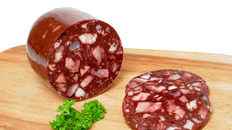Meats and Sausages
Black Head Cheese (Salceson Czarny)
| Meats | Metric | US |
|---|---|---|
| Pork jowls | 400 g | 0.88 lb |
| Hearts and kidneys | 100 g | 3.52 oz |
| Pork or veal lungs, boiled beef, veal or lamb head meat, boiled (not salted) bone meat, pork trimmings | 100 g | 3.52 oz |
| Skins, pork or veal leg meat | 100 g | 3.52 oz |
| Blood | 250 g | 0.55 lb |
| Semolina, bread crumbs or bread crust | 50 g | 1.76 oz |
Ingredients per 1000g (1 kg) of meat
| salt (for curing) | 6 g | 1 tsp |
| cure 1 (for curing) | 2.5 g | 1/2 tsp |
| salt | 12 g | 2 tsp |
| marjoram | 1.0 g | 1/2 tsp |
| pepper | 2.0 g | 1 tsp |
| garlic | 3.0 g | 1 clove |
Instructions
- Curing. Cut meats into 1 inch (25 mm) pieces and then mix with salt and cure 1. Pack tight and place in refrigerator for 48 hours. Meats not cured will not develop pink color.
- Poach meats in a small amount of water
- hearts, kidneys, lungs at 85°C (185°F) until soft.
- skins, heads and legs at 95°C (203°F) until soft.
- jowls at 85°C (185°F) until semi-soft.
- After poaching remove gristle from lungs and meat from heads and legs. Spread apart on a flat surface to cool.
- Cut jowls into 10-12 mm ( 3/8-1/2”) cubes. Grind skins through 1/8" (3 mm) plate. Grind other meats through 1/8" (3 mm) plate.
- Mix salt, spices, semolina or bread crumbs with ground meats and blood.
- Stuffing. Sausage casings: pork ( middles, bladders or stomachs), veal (bungs), lamb (bungs), beef (large or medium bungs), 100 mm synthetic casings. Stuff casings loosely and sew (or tie) the ends with butcher twine.
- Cook head cheeses in water at 82°C (180°F) for 90-120 min (depending on size) until the internal temperature of the meat reaches 68-70°C (154-158°F). Remove air with a needle from pieces that swim up to the surface.
- Spread head cheeses on a flat surface at 2-6°C (35-43°F) and let the steam out. Then flatten them with weight and cool them to below 6°C (43°F). If there is no proper cooler available, cool them down to less than 12°C (53°F)
- After cooling clean head cheeses of any fat and aspic that accumulated on the surface, even them out and cut off excess twine.
Notes
Lamb meat total must not exceed 5% (50 g per 1 kg meat total). In case that meats are partly salted this fact must be taken under consideration when adding salt during production. Depending on a regional preference semolina or bread crumbs may be replaced with more skins.
Marjoram may be removed from the recipe and garlic may be substituted with 10 g (1 tablespoon) of chopped onion. Allspice may be added, 0.5 g (1/2 tsp).
Final shape will depend on individual characteristics of a casing used. Approximated sizes (length x width x height in centimeters): pork middles (25 x 12 x 7), bladders (2 x 20 x 7), stomachs (25 x 15 x 7), veal or lamb bungs (18-25) x 12 x 7, beef bungs (40-45) x (8-14) x (5-9).
Our note: pork jowls, hearts, leg meat; these meats contain a lot of connective tissue (collagen) and will produce natural gelatin that will bind everything together. You can use different meats, however, make sure that you have enough meat trimmings that are rich in connective tissue (skin, sinews, tendons, silver screen membrane).


















